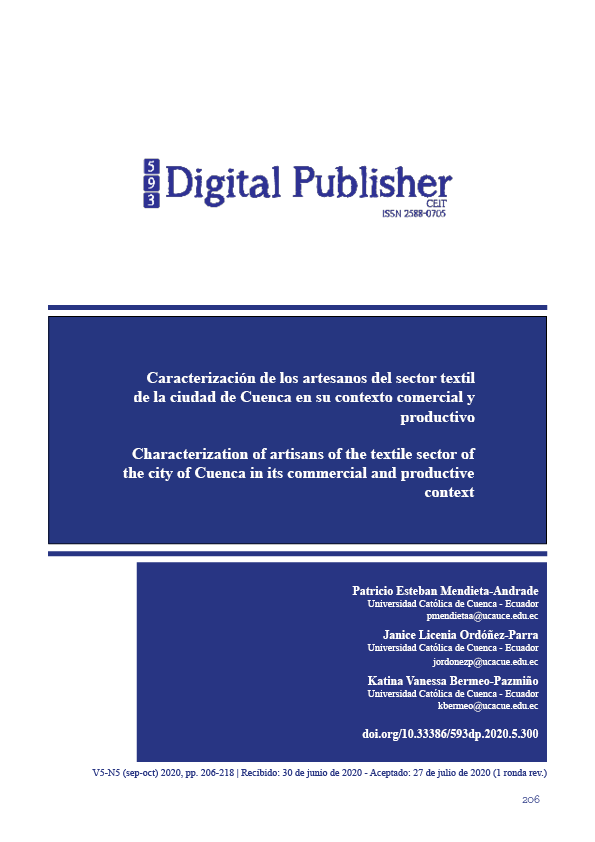Characterization of artisans of the textile sector of the city of Cuenca in its commercial and productive context
Main Article Content
Abstract
This article exposes and analyzes the main characteristics of the artisans of the textile sector of the city of Cuenca, recognizing their particularities within the commercial and economic context in which they operate. The data was obtained by applying surveys to a group of artisans belonging to the textile union of the Provincial Federation of Professional Artisans of Azuay. Thus, sports clothing was identified as its main product, which is mainly marketed to end consumers, through enterprises formally constituted from the tax perspective and under the scheme of natural persons. The problem regarding the under-occupation of its installed capacity is highlighted, which generates an increase in its cost level.
Downloads
Article Details
1. Derechos de autor
Las obras que se publican en 593 Digital Publisher CEIT están sujetas a los siguientes términos:
1.1. 593 Digital Publisher CEIT, conserva los derechos patrimoniales (copyright) de las obras publicadas, favorece y permite la reutilización de las mismas bajo la licencia Licencia Creative Commons 4.0 de Reconocimiento-NoComercial-CompartirIgual 4.0, por lo cual se pueden copiar, usar, difundir, transmitir y exponer públicamente, siempre que:
1.1.a. Se cite la autoría y fuente original de su publicación (revista, editorial, URL).
1.1.b. No se usen para fines comerciales u onerosos.
1.1.c. Se mencione la existencia y especificaciones de esta licencia de uso.
References
Arteaga, D. (2008). Los artesanos de Cuenca entre 1557 y 1822. En CIDAP. Cuenca: CIDAP.
Congreso Nacional . (1986). Ley de Fomento Artesanal . Registro Oficial No. 446 del 29 de mayo de 1986.
Congreso Nacional. (1971). Ley de Defensa del Artesano. Registro Oficial 71, del 23 may 1971.
FONART. (2018). Propuesta de Atención del Programa del Fondo Nacional para el Fomento de las Artesanias. Obtenido de https://bit.ly/2Pzza2f
FONRAT. (2014). Catálogo de artesanía mexicana . Obtenido de https://bit.ly/2whUxi4
Forstner, K. (2013). La artesanía como estrategia de desarrollo rural: el caso de los grupos de arteanas en la región de Puno (Perú). Cuadernos de Desarrollo Rural, 10(72), 141-158. Obtenido de http://www.scielo.org.co/pdf/cudr/v10n72/v10n72a08.pdf
Freitag, V. (2014). Entre arte y artesanias: elementos para pensar el oficio artesanal en la actualidad. El Artista(11), 129-143. Obtenido de https://www.redalyc.org/pdf/874/87432695007.pdf
Freitag, V., & Carpio, P. (2016). Memorias del oficio artesanal: un estudio con alfareros tonaltecas. Relaciones. Estudios de historia y sociedad, 37(148), 243.-274. Obtenido de http://www.scielo.org.mx/scielo.php?script=sci_arttext&pid=S0185-39292016000600243&lng=es&tlng=es.
Fundación Municipal Turimo para Cuenca. (s/f). Rutas vivenciales artesanía cuencanas. Obtenido de https://bit.ly/39GVBuy
Gobierno de México. (2020). Fondo Nacional para el Fomento de las Artesanías. (M. F. Ciudad de México, Productor) Obtenido de https://www.gob.mx/fonart
Hernanández, R., Fernández, C., & Baptista, M. (2014). Metodología de la investigación. México D.F: McGraw Hill/ Interamericana Editores, S.A de C.V.
Hernández, V., Pineda, D., & Andrade, M. (2011). Las mipymes artesanales como un medio de desarrollo para los grupos rurales en México. Universidad & Empresa, 13(21), 65-92. Obtenido de https://www.redalyc.org/articulo.oa?id=187222420004
Herrera, Y., Armas, M., & Guerrero , A. (2018). Arreglos Productivos Locales en el Sector Artesanal de Atacames, Provincia Esmeraldas, Ecuador. Revista Científica Hallazgos21, 3. Obtenido de https://revistas.pucese.edu.ec/hallazgos21/article/view/244
INEC. (2012). Clasificación Nacional de Actividades Económicas. Obtenido de https://aplicaciones2.ecuadorencifras.gob.ec/SIN/descargas/ciiu.pdf
INEC. (2019). Directorio de empresas 2018. Obtenido de https://bit.ly/39p4kRQ
Jail, N., Roque, Y., & Paz, L. (2018). La asociatividd para el fortalecimiento de los artesanos productores de la semilla de la tagua en la comunidad de Sosote, Manabí, Ecuador. Universidad & Ciencias, 248-263. Obtenido de https://bit.ly/2TtHuD5
Largacha, M. (2011). Caracterización del artesano de la provincia guanentina: ¿quimera o realidad? IconoFacto Revista de la Escuela de Arquitectura y Diseño, 7(9), 76-101. Obtenido de https://bit.ly/2OV4qbU
Malo, C. (2009). El futuro de las artesanias y el reto de la globalización. Universitas: Revista de Ciencias Sociales y Humanas(11), 153-164. doi:https://doi.org/10.17163/uni.n11.2009.09
Meier, P. (1985). La economía política del Ecuador: campo, región, nación. En FLACSO. Quito: Corporación Editora Nacional. doi:https://biblio.flacsoandes.edu.ec/libros/16543-opac
Ministerio de Industria Comercio y Mipymes de República Dominicana. (2018). Caracterización de los talleres de joyería artesanal de la República Dominicana. Obtenido de https://www.micm.gob.do/images/pdf/publicaciones/libros/informes/2019/Informe_caracterizacion_talleres_artesania.pdf
Montero, S., & Calderón, N. (2020). Asociatividad, liderazgo inclusivo y desarrollo económico local. El Grupo de Artesanos Independientes de Mompox. Bitácora Urbano Territoria, 30(1), 193-204. doi:https://doi.org/10.15446/bitacora.v30n1.62160.
Presidencia de la República. (2018). Reglamento de inversiones del Código Orgánico de la Producción, Comercio e Inversiones. [Decreto ejecutivo 617]. Registro Oficial S. 450.
Ramírez, D., Rodríguez, S., Cutiño, A., Leite, E., Pérez, Y., Valdespino, C., . . . Gil, M. (2016). Artesanos emprendedores de la artesanía local en la provincia de Granma, Cuba. HOLOS, 3, 218-228. Obtenido de https://www.redalyc.org/pdf/4815/481554866017.pdf
Ramón, C., Calderón, Y., García, M., & Espinoza, M. (2018). La ropa de tipo artesanal: desafíos y oportunidades en su comercialización. Visión de futuro, 22(2), 1-19. Obtenido de https://visiondefuturo.fce.unam.edu.ar/index.php/visiondefuturo/article/view/281
Rodríguez , A., & Pérez, A. (2017). Métodos científicos de indagación y de construcción del conocimiento. Revista EAN, 82, 179-200. doi:https://doi.org/10.21158/01208160.n82.2017.1647
Rojas, M. (2015). Tipos de investigación científica: Una simplificación de la complicada incoherente nomenclatura y clasificación. REVET, 16(1), 1-14. Obtenido de https://www.redalyc.org/pdf/636/63638739004.pdf
UNESCO. (s/f). Artesanía y diseño. Obtenido de http://www.unesco.org/new/es/culture/themes/creativity/creative-industries/crafts-and-design/
Vizcaino, L., Serrano , R., Cruz, G., & Pastor, M. (2017). Turismo, alfarería y trabajo femenino en el Pueblo Mágico de Metepec, México. PASOS. Revista de Turismo y Patrimonio Cultural,, 15(2), 391-407. Obtenido de http://ojsull.webs.ull.es/index.php/Revista/article/view/1115




